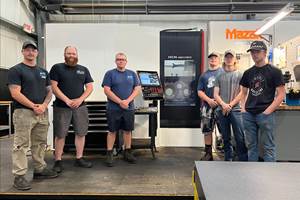How to Deal with Complexities That Affect Worker Skill Levels
The goal must be to keep tasks as simple as possible for those who perform them.
My theme in recent months has been factors that contribute to your company’s corporate identity as well as how they affect your computer numerical control (CNC) environment. Here, we consider the impact that complexity has on your shopfloor personnel.
My rather broad definition of complexity includes anything that makes it more difficult to appropriately produce acceptable workpieces on CNC machine tools. In my opinion, there are two general factors that contribute to your company’s manufacturing complexity: the workpiece configuration/ design and the machining processes required to produce the workpiece.
Some workpieces and processes are obviously more complex than others. Determining an average throughout your company will provide a general view of this important factor. Regardless of this average, you still must be able to accommodate that company’s most complex workpiece configurations and manufacturing processes.
How do you assess your company’s complexity level?
Rate your company’s complexity level by analyzing workpiece configuration. From a manufacturing standpoint, obvious complexity-related attributes include a workpiece’s general size and shape, the required machining operations and production processes, tolerance specifications and how many pieces must be produced.
Manufacturing process must be appropriate to workpiece complexity. Additionally, you must look for ways to minimize the skill level required of the people performing the specific tasks related to manufacturing processes. For instance, manufacturing engineering personnel should enhance/simplify techniques used for making setups, running workpieces, inspecting completed parts and reporting results whenever possible.
Consider a company that has very small lots (possibly only one) of large, heavy, odd-shaped workpieces requiring multiple machining operations on different machine tools—including five-axis CNC machines—and having very small tolerances. If this is your norm, your focus must be on material handling, program-preparation systems and quality control, among other concerns. The goal must be to keep things as simple, or at least as feasible, as possible for the people involved.
On the other hand, if your company machines larger lots of workpieces that are smaller and simpler, easier to handle and have larger tolerances, your complexity-related challenges will be much different and probably simpler. But the goal must remain the same: to simplify required tasks for those who perform them on the shop floor.
Your company’s complexity level has an impact on everyone. The higher the complexity level, the more skill and knowledge is required of the people involved, starting with the design engineers and ending with those in your shipping department.
Manufacturing engineering personnel can do a great deal to help, assuming they have the skills to deal with workpiece-design complexities. They must act as a buffer between design engineers and shopfloor employees, translating complicated design-engineering concepts into shopfloor documentation and methods that hopefully can be easy to follow.
This concept is critical. The better engineered the manufacturing process, the simpler the tasks will be that must be performed. In turn, the simpler the related tasks, the lower the skill levels that will be required of the people performing them.
Even process-engineering efforts have their limits. Shopfloor personnel must possess the skills to do their jobs. Either they must already have these skills when you hire them, which is unlikely even with the simplest complexity levels, or more likely, you must provide targeted training to bring them to a level that allows them to be proficient performing the required tasks.
Related Content
Top Shop Builds Upon Employee Ownership for Future Success
In its quest to become the Fox Valley’s best-in-class employer, A to Z Machine has adopted an ESOP, expanded benefits and invested in apprenticeships.
Read MoreHow to Grow the Business with Real-Time Job Status Data
ERP systems that focus on making data more accessible can improve communication within a shop, reducing wasteful errors and improving capacity.
Read More6 Tips for Training on a Swiss-Type Lathe
There are nuances to training a person to effectively operate a Swiss-type lathe. Derek Korn, Production Machining’s editor in chief, shares suggestions from a CNC machine shop.
Read MoreSolve Worker Shortages With ACE Workforce Development
The America’s Cutting Edge (ACE) program is addressing the current shortage in trained and available workers by offering no-cost online and in-person training opportunities in CNC machining and metrology.
Read MoreRead Next
3 Mistakes That Cause CNC Programs to Fail
Despite enhancements to manufacturing technology, there are still issues today that can cause programs to fail. These failures can cause lost time, scrapped parts, damaged machines and even injured operators.
Read MoreThe Cut Scene: The Finer Details of Large-Format Machining
Small details and features can have an outsized impact on large parts, such as Barbco’s collapsible utility drill head.
Read More
.jpg;width=70;height=70;mode=crop)















.png;maxWidth=300;quality=90)









